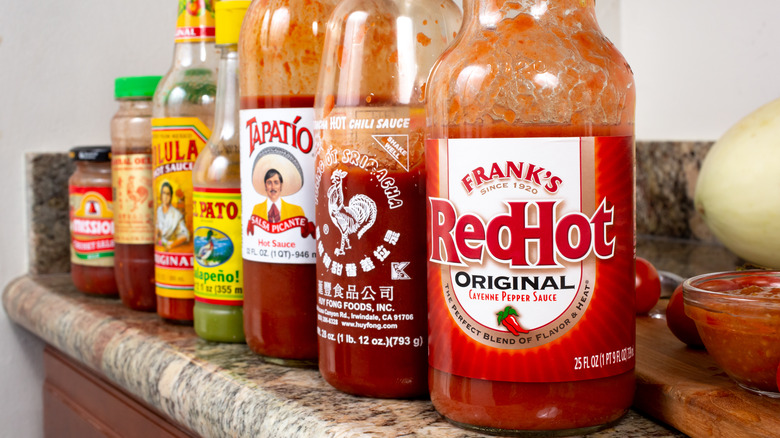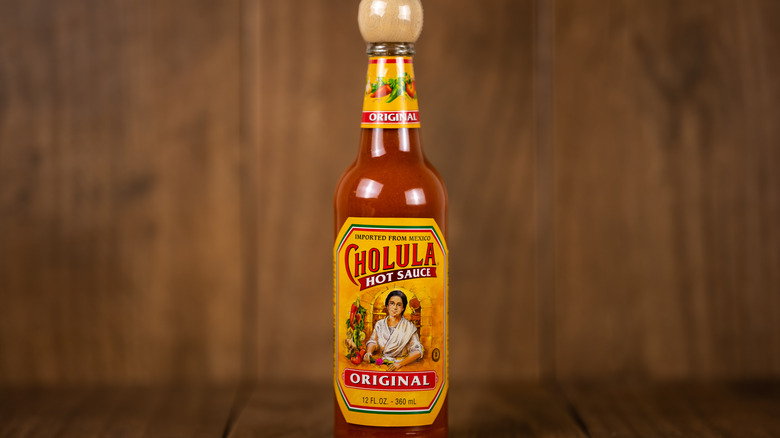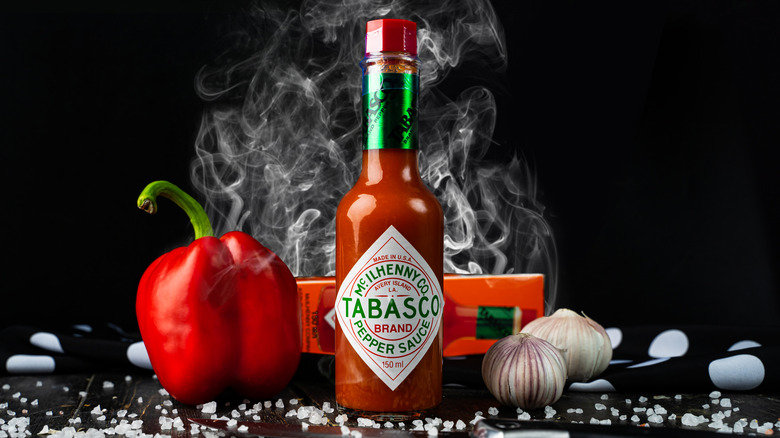How To Tell Water And Vinegar Based Hot Sauces Apart By The Flavor
If you're at the store on the hunt for the best hot sauces, consider whether you prefer water based or vinegar based. The easiest way to tell the difference is right there in the flavor: Vinegar based hot sauces are much more acidic and sharp in nature than water based hot sauces. This isn't to say that water based hot sauces are completely devoid of vinegar, though. Even water based varieties contain a sizable amount of vinegar or acetic acid in their formulas for preservation purposes, which is why all commercial hot sauces are usually very tangy. However, water based hot sauces contain only the required amount of approximately 20 to 30%, while vinegar based hot sauces are predominantly made up of vinegar.
Another indication is the texture and viscosity of the sauce itself. Water based hot sauces are usually more sauce-like; they have a hint of solidity, and they're more opaque. Their vinegar based counterparts, on the other hand, are translucent and tend to run like liquid.
Water based hot sauces are chili forward
While some hot sauces are identified as "water based," they are often made from peppers that have been turned into a paste. This means that you'll be getting way more of the chili than you would the sour vinegar flavor. Some of the most prominent water based hot sauces are made by Cholula, Tapatio, and Valentina. These three sauces are all opaque in appearance and offer an almost fruity spice to any dish you add them to.
You can also tell that these options are water based by looking at the ingredients list. Cholula, Tapatio, and Valentina all include water as the first ingredient because they're made from dried chilies that have been rehydrated by water. Cholula hot sauce, for example, is primarily peppers (90%) which have been dehydrated and then boiled into a paste. The paste is combined with a vinegar and carrot powder blend to create the finished product. Cholula is made from arbol and pequin peppers, which are bold and balanced between sweet and spicy. Tapatio is made out of a mysterious red pepper, but Valentina is made from puya peppers, which are mild in spice and fruity. These sauces make great additions to ketchup and aioli, and can complement carb-heavy dishes like loaded tots. For any dish that you want to infuse with spice without incurring the strong hit of vinegar on your palate, these water based hot sauces are the way to go.
Vinegar based hot sauces are as sour as they are spicy
On the other end of the spectrum are the runnier vinegar based hot sauces like Tabasco, Frank's Red Hot, and Texas Pete. These are also known as Louisiana-style hot sauces, and they consist primarily of chilies, vinegar, and salt. You should use this type of hot sauce more sparingly, since the vinegar and spice can overwhelm your palate.
Tabasco is made from tabasco peppers that have been fermented in barrels with salt. The salted pepper mash is combined with vinegar and left to steep in the liquid until it takes on the spice and color of the peppers. Once you strain the whole mixture through a fine mesh sieve, you have a finished hot sauce. The pepper mash is sadly discarded, but the result is a spicy and versatile tabasco-flavored vinegar. Frank's Red Hot is made from cayenne peppers that are also fermented for an undisclosed period of time. Then, this fermented cayenne is cooked with vinegar and spices before being bottled. Unlike water based hot sauce, Frank's Red Hot offers an equal amount of acidity and spice that may overpower neutral dishes. Texas Pete is another classic vinegar based hot sauce with vinegar as the first listed ingredient. Also made from cayenne peppers, this classic American option offers a hefty level of spice that isn't quite unbearable.
Any of these are delicious in small doses on breakfast items and marinades. Just be sure to account for the acidity!


